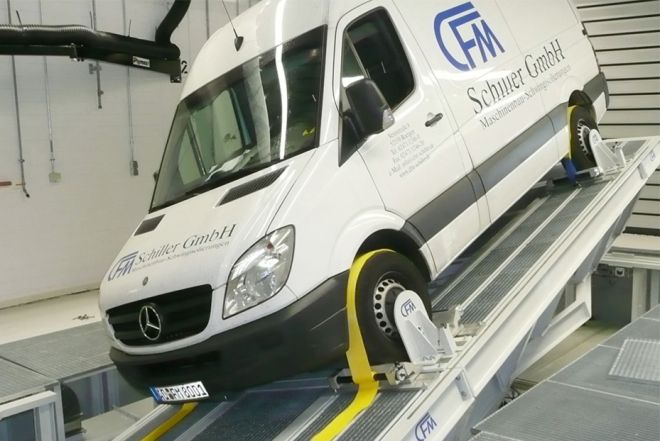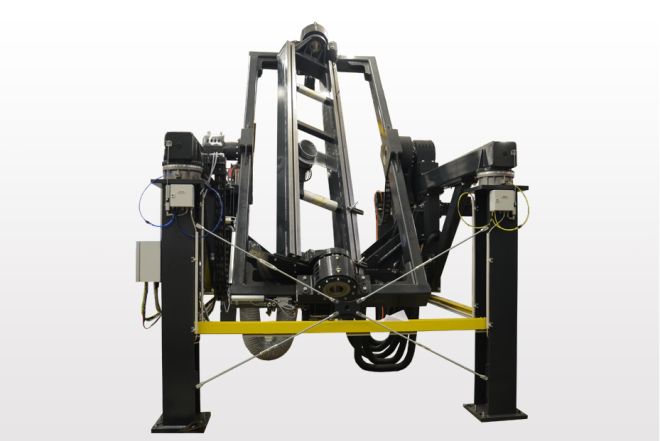Inclination Test Rigs
Inclination or tilting test rigs from CFM Schiller are applied in many fields of vehicle and engine development. They simulate operating conditions like inclination, acceleration and deceleration for performance testing.
CFM Schiller designs, manufactures, and installs tilting test rigs in 1-axial and 2-axial versions. They are developed for high-dynamic applications. An inclination test rig, which is a special type of tilting test rig, is used for quasi-static testing.
Inclination test rig for large combustion engines
Even in the age of advancing electrification, internal combustion engines are the most important drive for vehicles, mobile machines and ships worldwide. In order to guarantee the reliability and operational safety of such combustion engines, manufacturers are forced to carry out very extensive endurance tests under a wide range of environmental and operating conditions.
Many powerful internal combustion engines are used in agricultural machinery, snow groomers and also ships, which not only move on flat surfaces, but also work on slopes in the mountains or are used under heavy waves at sea. Especially with marine engines, operational safety is vital for the ship's crew.
In order to simulate these operating conditions in the laboratory, it is necessary to operate and test these combustion engines under "sloping conditions". Here, the focus is on the lubrication behaviour and the function of the various fluid circuits.
The inclination test rig developed by CFM Schiller is designed for engines with a power output of up to 8,000 hp and a weight of up to 16 tonnes. The inclination test rig can be tilted in two axes up to an angle of +/- 45° with a maximum tilting speed of 15°/second. This is very fast considering the test rig's size. The swivel frame is accelerated to the final speed within 1.5 seconds.
The test rig is based on the principle of cardanic bearing in two axes and is driven by electric servo drives and sprockets. When selecting the drive concept, CFM Schiller attached particular importance to the test rig being very energy-saving and service reduced. Here, the electric drive has proven to be a clear advantage over hydraulic concepts that were installed in their predecessors.
Inclination Test Rig
Inclination test rigs for large marine diesel engines and motor generator units from CFM Schiller are particularly designed for examination of the water and lubrication system in those engines.
CFM Schiller has developed these test rigs for the marine and offshore industry to comply with the very strict requirements regarding operating safety of technical equipment and machinery. Guidelines for type approval tests stipulate that marine engines must operate reliably and faultlessly under an inclination of 25° in order to guarantee continuous power supply to ships and oil platforms at all times.
By order of a world-famous manufacturer of large marine diesel engines, CFM Schiller has developed a 2-axial inclination test rig, which simulates the required angle of list for ships and offshore platforms. The inclination test rig can provide inclinations of 25° in both axes; respectively longitudinal axis and transversal axis of the engine.
The maximum weight of the specimens, comprising diesel engine and generator, is 200 tons. Because of the enormous weight, a heavy-duty crane is necessary to place the specimens on the test rig. If no crane is available, the entire test rig can be disconnected from the ground, put on air cushions, and can then be moved to another workshop with suitable crane. This inclination test rig is the very first of its kind – worldwide.
Dimensions and Weight: Test rig weight: 197 t | Length: 16 500 mm (54.13’) | Width: 6 350 mm (20.83’) | Height: 4 500 mm (14.76’)
Tilted Refueling Test Rig
The tilted refueling test rig from CFM Schiller is designed for testing of fuel systems in motor vehicles. This particularly comprises examinations of fuel tanks and the suction properties of the entire fuel system.
The tilt platform can be inclined about ±15° in both longitudinal and transversal direction of the vehicle. Its dimensions are 7 000 x 3 500 mm (22.96’x11.48’). To achieve full inclination without any collisions, the platform vertically lifts 1 000 mm (39.37”) from its zero level to operating level. In zero level, the specimen vehicle can be easily driven onto the platform.
4 hydraulic actuators with proportional valves drive the test rig. It is controlled by means of a PLC and a touch screen as user interface.
Inclination Test Rig for Transmissions
For examination of lubrication and foaming characteristics of vehicle transmissions under realistic conditions, CFM Schiller offers high-dynamic, 2-axial inclination test rigs.
The transmission to be tested is placed on the tilt platform, connected to an input dynamometer and an output dynamometer.
The tilt platform has been optimized regarding weight and stiffness. The demands of high accelerations and large masses in motion are met this way while simultaneously reducing loading on the actuator that drives the test rig.
The given tilting test rig has a tilt platform measuring 7 m x 4 m (22.9’ x 13.1’). Each axis allows a tilting angle of ±53° and a tilting velocity of 30°/s.
Inclination Test Rig for Combustion Engines
2-axial inclination test rigs from CFM Schiller are particularly applied in development of internal combustion engines. They are used for examination of lubrication characteristics during operation under varying inclination.
This testing procedure is of high importance for combustion engines in off-road vehicles, forestry and agricultural machinery, construction machinery as well as ships.
CFM Schiller develops inclination test rigs for dynamic testing about 2 axes; the longitudinal axis and the transversal axis of the engine. Both axes feature a tilting angle of at least ±45°. Tilting velocities are continuously controlled. Depending on application and the corresponding design, the test rig is driven with servo-controlled hydraulic motors, electric motors with transmission, or with hydraulic or electric linear actuators.
CFM Inclination Test Rigs provide a control system for the respective drive units. Operation can be carried out via hand panel with digital display (touch screen). An interface to the superior engine test rig control system is available. This allows desired values and profiles for the tilting angle to be set externally. Both input dynamometer and specimen engine are controlled with external systems from well-known manufacturers.








